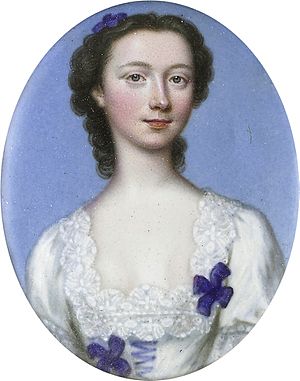Catherine Talbot facts for kids
Catherine Talbot (born May 1721 – died 9 January 1770) was an English writer and a member of the Blue Stockings Society. This group was made up of educated women who met to discuss literature and other interesting topics.
Her Early Life and Education
Catherine Talbot was born after her father, Edward Talbot, passed away. Her father was the second son of William Talbot, who was a bishop (a high-ranking church leader) in Durham. Her uncle, Charles Talbot, was a very important lawyer called the Lord Chancellor.
When Catherine was young, her family wasn't very wealthy. In 1725, her mother and Catherine went to live with Thomas Secker and his wife, Catherine Benson. Thomas Secker was a close friend of Catherine's father. They stayed with the Seckers until Thomas Secker died in 1768.
Thomas Secker took charge of Catherine's education. She became very knowledgeable about the Bible and learned many languages. She also enjoyed painting with watercolors and reading a lot of books. People noticed her talent from a young age.
Friendships and Social Life
In 1741, Catherine Talbot became lifelong friends with Elizabeth Carter. They were introduced by Catherine's astronomy teacher. The two friends wrote many letters to each other, sharing their thoughts and ideas.
As Thomas Secker became more important in the church (he became a bishop and then an archbishop), Catherine Talbot met many important people of her time. She knew famous writers like Samuel Richardson, who wrote novels. Richardson even asked for her and Elizabeth Carter's ideas for his book Sir Charles Grandison before it was published. Catherine also encouraged Elizabeth Carter to translate an important ancient Greek book by Epictetus.
Catherine Talbot also helped Thomas Secker manage his charity work. She was his almoner, which meant she helped him give money and help to people in need.
In 1760, Catherine went to Bristol with Elizabeth Carter because she wasn't feeling well. Thomas Secker passed away in 1768. He left money to Catherine and her mother. Catherine Talbot died from cancer in 1770 when she was 48 years old.
Her Writings
Catherine's health often prevented her from working continuously. She wrote many essays and short pieces in a special "green book." Her friends really liked her writings, but they couldn't convince her to publish them herself. However, she did contribute one article to a famous magazine called The Rambler in 1750, which was run by Samuel Johnson.
After Catherine died, her mother gave Catherine's writings to Elizabeth Carter. Elizabeth Carter decided to publish them. In 1770, she published Catherine Talbot's Reflections on the Seven Days of the Week. This book contained thoughts on religious and moral topics and was reprinted many times. In 1772, another book by Catherine Talbot, Essays on Various Subjects, was published. This book included essays, dialogues (conversations), fairy tales, and poems. Her letters to Elizabeth Carter, published later, show that she was interested in public events and had a good understanding of people.


